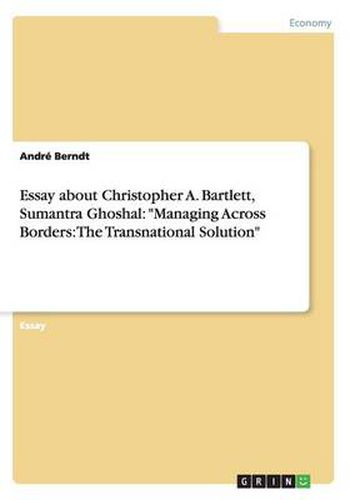Readings Newsletter
Become a Readings Member to make your shopping experience even easier.
Sign in or sign up for free!
You’re not far away from qualifying for FREE standard shipping within Australia
You’ve qualified for FREE standard shipping within Australia
The cart is loading…






Essay from the year 2003 in the subject Business economics - Business Management, Corporate Governance, grade: Excellent (Grade A), University of Jyvaskyla (School of Business and Economics; Department of Management and Leadership), course: Competitive Strategies, language: English, abstract: The book Managing Across Borders, The Transnational Solution by Christopher A. Bartlett and Sumantra Ghoshal is about the challenges of international business particularly in 1980s. The authors divided the book in three main parts. The first part, called The Transnational Challenge , deals mainly with conceptual issues like the definition of multinational, global and international companies as well as structural fit and administrative heritage. Accordingly this chapter of the book tries to answer the question why nowadays transnational organisations are needed. The second part, called Characteristics Of The Transnational , describes mainly the three key attributes of the transnational organisation. Which are the integrated network configuration of assets and activities, flexibility due to specialised roles and responsibilities and last but not least the facilitation of learning due to multiple innovation processes. Therefore this part of the book considers the question what is the transnational organisation. The third part of the book, called Building And Managing The Transnational prescribes mainly what managers have to do in order to build and manage an organisation that corresponds to the model of the transnational organisation. This means that, this chapter tries to answer the question how can a transnational organisation be build. Not to mention there is a fourth part in the studied book, called Appendix: Research Methology in with the authors describe their method of research and data collection more detailed than within the first three parts of the book. Succeeding I am going to summarise the content of each part more detailed.
$9.00 standard shipping within Australia
FREE standard shipping within Australia for orders over $100.00
Express & International shipping calculated at checkout
Essay from the year 2003 in the subject Business economics - Business Management, Corporate Governance, grade: Excellent (Grade A), University of Jyvaskyla (School of Business and Economics; Department of Management and Leadership), course: Competitive Strategies, language: English, abstract: The book Managing Across Borders, The Transnational Solution by Christopher A. Bartlett and Sumantra Ghoshal is about the challenges of international business particularly in 1980s. The authors divided the book in three main parts. The first part, called The Transnational Challenge , deals mainly with conceptual issues like the definition of multinational, global and international companies as well as structural fit and administrative heritage. Accordingly this chapter of the book tries to answer the question why nowadays transnational organisations are needed. The second part, called Characteristics Of The Transnational , describes mainly the three key attributes of the transnational organisation. Which are the integrated network configuration of assets and activities, flexibility due to specialised roles and responsibilities and last but not least the facilitation of learning due to multiple innovation processes. Therefore this part of the book considers the question what is the transnational organisation. The third part of the book, called Building And Managing The Transnational prescribes mainly what managers have to do in order to build and manage an organisation that corresponds to the model of the transnational organisation. This means that, this chapter tries to answer the question how can a transnational organisation be build. Not to mention there is a fourth part in the studied book, called Appendix: Research Methology in with the authors describe their method of research and data collection more detailed than within the first three parts of the book. Succeeding I am going to summarise the content of each part more detailed.